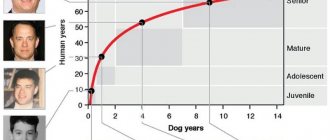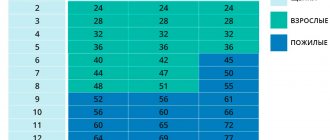Although dogs live shorter lives than their owners, just like people, they go through various stages of life, including childhood, adolescence, maturity and old age. And understanding what age a pet is by human standards will help you understand it, determine its needs and find an approach to raising it. But, since there are different approaches to how to recalculate dog years to human age, it is necessary to determine the option that is closest to reality.
How to calculate a dog's age - a modern approach
Converting dog years to human ages is a complex task that requires taking into account many factors. It is impossible to fully cover all aspects of development, physiological characteristics in accordance with the breed and living conditions of pets. Therefore, for calculations, data obtained from companies insuring pets and from veterinary clinics is used, plus statistics from examinations carried out in kennel clubs are collected. Based on this, in 2022, a group of scientists from America decided to conduct their own research, according to which they were able to create a formula that allows them to calculate dog years:
Pet's age in human years = 16 × ln(dog's age) + 31,
where ln is the natural logarithm
Logarithmic function for epigenetic translation from dog age (x-axis) to human age (y-axis). Illustration from the study Quantitative translation of dog-to-human aging by conserved remodeling of epigenetic networks
A more simplified approach is offered by the American Veterinary Medical Association: their general guidelines state that the age of pets by human standards can be calculated as follows:
- The 1st year of a dog’s life is equal to 15 human years.
- In the 2nd year, the pet lives 9 human years.
- Each subsequent year is equivalent to 5 human years.
Causes of premature death in Labradors
Typically, premature death of Labradors is associated with a number of diseases:
- Gastric volvulus. Due to the weakness of the muscle walls, the stomach begins to enlarge, and therefore puts pressure on the diaphragm and internal organs. This leads to circulatory impairment and subsequent death.
- Tracheal collapse. Hereditary disease with a chronic course.
- Tumor of the spleen. It is dangerous because it can rupture even from minor mechanical impact. As a result, the dog dies from profuse internal bleeding.
- Choking due to a bone getting into the throat.
- Diseases of the cardiovascular system.
The unnatural death of a Labrador can occur from an accident: getting hit by a car, poisoning, etc. Therefore, it is important that the dog is well trained and follows commands despite distractions.
How was the age of dogs calculated in the past?
For a long time, people were interested in how to understand how old a dog is in comparison with them. Therefore, research was carried out and assumptions were made. Some theories were close to reality, others were as far away as possible. But each should be considered separately.
1 dog year = 7 human years
Initially, it was decided that the age of dogs was calculated simply - 1 human year is equal to 7 dog years. This judgment arose by dividing the average life expectancy of a person, taken as 70 years, by the average life expectancy of pets, taken as 10-12 years.
The formula was subject to serious criticism, since it assumed that by the end of the first year of life, a furry pet is developed at the level of a 7-year-old child, and by the end of the second, it reaches the level of a 14-year-old teenager. But since a one-year-old dog is considered an adult, since the dog is capable of reproducing, and the human body matures up to 14-15 years, the calculation lost its meaning and became erroneous.
The theory of the French veterinarian Lebeau
The Frenchman Lebeau, who worked as a veterinarian, in 1950, conducted a series of studies on the physiology of dogs and proposed a new approach to calculation. In its version, dog years are correlated not only with the overall length of life, but also with the physical and psycho-emotional development of the pet. Lebeau suggested that it would be possible to translate dog ages according to humans as follows:
- 1 year is equivalent to 15 years.
- 2 years corresponds to 24 years.
- 3 years are equivalent to 28 years and then 4 human years are added every year.
That is, as a result of his research, from the age of 2, four-legged family members lived 1 year as 4 years of a person. But since Lebeau did not take into account the individual characteristics of pets and the conditions in which they were kept in his studies, such a calculation was considered suitable only for pets of small breeds.
Swiss biologist Kleiber's law
Max Kleiber, Swiss biologist
Swiss scientist Max Kleiber, being a biochemist by profession, was able to create the most accurate theory. In his research, he was guided by a previously discovered law that spoke about metabolic processes in the animal body, and through a series of experiments he was able to find out that large animals live longer. But this system works in the opposite way in the case of dogs. Based on his work, we can say that the older dogs become, the greater the difference between their biological age and the corresponding human years.
This trend can be illustrated by the Pekingese and Labrador. A Pekingese turns 15 years old in one year, 23 years old in 2 years, and 36 years old in 5 years. And in the case of a Labrador, in one year it is comparable to a 14-year-old teenager, in 2 years the Labrador reaches 29 years old by human standards, and in 5 years it reaches 45 years.
But there are also exceptions. It is known that the body of small breed dogs contains substances that help slow down the aging process, which increases the years of life.
Caring for an elderly dog
At an advanced age, Labradors can become passive, irritable and disobedient. During this period they need special attention and care:
- Nutrition should be balanced. It is important not to overfeed your pet: over the years, a tendency to gain weight and develop gastrointestinal diseases develops.
- There is no need to worry or disturb the animal. A stable, stress-free environment is optimal for the mental state of an aging dog.
- It is necessary to ensure that the Labrador does not suffer from heat, drafts or hypothermia.
- You should not put too much physical strain on your dog. With age, joints become more fragile, and therefore the likelihood of getting a dislocation, fracture, etc. increases.
How long a Labrador will live depends primarily on the owner. If you choose a puppy with good heredity and provide him with proper care, he will delight his owner for many years.
Dog age to human age
You can determine how old a dog is in human years by taking into account which weight group the pet belongs to:
- Small – 9 kg or less.
- Average – 10-21 kg.
- Large – 22-45 kg.
- Huge - 46 kg or more.
1 year
By human standards, the first dog year for a small, medium and large dog is equivalent to 15 years, and for a large dog - to 12.
2 years
At 2 years, the ratio of the age of a dog to a person for small, medium and large pets is equal to 24 years, for large ones - to 22.
3 years
Having reached 3 years old, a small, medium and large dog is developed at the level of a 28-year-old person, and a huge one - at the level of a 31-year-old person.
4 years
Having lived for 4 years, a small, medium in weight and large dog is considered 32 years old by human standards, a huge one is 38 years old.
5 years
At the onset of the 5th year of life, the dog years of a small, medium and large pet in human years are equal to 36, and for a large pet to 45.
6 years
Starting at 6 years of age, a difference in human years is present in all dogs:
- small – 40 years;
- average – 42 years;
- large – 45 years;
- huge - 49 years old.
By the age of 6, a small furry companion reaches 40 human years, a medium one - 42, a large one - 45, a huge one - 49.
7 years
At the age of 7, a four-legged family friend is considered to be developed by analogy with a person:
- small – 44,
- average – 47,
- large – 50,
- huge – 56.
8 years
By the age of 8, the psychological and physical age of the pet, by human standards, approaches:
- small breeds – 48;
- representatives of medium breeds – 51;
- large – 55;
- huge – 64.
9 years
At 9 years old, a small dog is considered to have reached 52 human years, a medium one - 56, a large one - 61, and a huge one - 71.
10 years
From the age of 10, dog years in small breeds approach 56 human years, medium - 60, large - 66, huge - 79.
11 years
Having lived like a dog for 11 years, the small four-legged friend turns about 60 years old, the medium one - 65, the big one - 72, the huge one - 86.
12 years
By the time a dog turns 12 years old, the psychological and physical condition of a dog of small breeds is translated into 64 human years, medium - 69, large - 77, huge - 93.
13 years
From 13 years of age, breeders can consider a small dog to have grown to 68 years of age. An average pet reaches 74 years, a large one - 82, a huge one - 100.
14 years
By the time a dog turns 14 years old, the dog years of a small dog, by analogy with people, are equal to 72 years, a medium one - 78, a large one - 88, a huge one - 100.
15 years
At the age of 15, a small pet is considered to have reached 76 human years, a medium one - 83, a large one - 93, and a huge one - 114.
16 years
Having reached 16 years of age, small dogs are compared to an 80-year-old person, medium - 87, large - 99, huge - 121.
17 years
At 17 years old, the dog age of representatives of small breeds is considered to be equal to 84 human years, medium - 92, large - 104, huge - 128.
18 years
By the onset of the 18th year of life, the human age for a small breed is equal to 88 years, for a medium breed - 96, for a large one - 110, for a huge one - 135.
Other age-related features in the life of a pet
During the life of a pet, behavioral characteristics are also observed at different stages.
- From the moment of birth until 18 days, the puppy is helpless. He is blind, deaf, and completely dependent on his mother. During this period, its main activity is feeding. The purpose of its movement (crawling) is to search for milk.
- From 15 to 21 days the puppy gets the opportunity to see and hear. He runs, jumps, actively reacts to external stimuli. Conditioned reflexes are being formed, including defensive ones.
- Starting from the 3rd week, the puppy gains weight rapidly and the brain mass increases.
- The period from 1.5 to 3 months is considered the most important from the point of view of puppy training.
- By 12 weeks , the mother’s guardianship ends and the baby comes “under the wing” of the owner. It is important at this moment to immediately accustom your pet to the rules established in the house. Mistakes made in parenting during this period can lead to serious problems in the future. This is especially true for guard and service dogs. The puppy must be taught to respond to its name, and also taught the simplest commands - “place”, “come to me”.
- The time of life from 3 to 7 months is the period of formation of the nervous system. It is at this age that the dog’s behavioral type is determined – active or passive.
Subsequently, the pet's character changes slightly. Changes occur in older dogs. They become less social, move little, and sleep more.
Age at which the first heat occurs
The first heat in female dogs occurs between 6 months in miniature dogs and 1 year in large breeds. In any case, it occurs after a complete change of teeth.
It may go unnoticed. In order not to miss this moment, the owner needs to note all changes in behavior. Dogs often show aggression towards males. This serves as one of the signs of puberty.
At what age can a dog be spayed?
- The issue of sterilizing a dog depends on whether the animal is planned to be used for breeding. If the answer is yes, sterilization seems advisable in old age, starting from 7-8 years.
- In other cases, to avoid problems with unnecessary pregnancy in females or excessive activity and aggressiveness in males, it is worth considering sterilization (castration) in the early stages of life.
girl
Bitches are usually spayed before their first heat. The age of females at this moment can be from 6 to 12 months . Therefore, if such a decision is made, it is necessary to clarify in advance with the breeder the features of the appearance of the first discharge in a particular breed.
Castrate a male dog
The general recommendation for castration of male dogs is that this procedure is carried out no earlier than 6-7 months. The main factor in determining the timing is the relationship with the pet’s puberty. In large dogs it can be completely completed by 12-18 months .
Age of teeth change
- Babies begin to erupt teeth at the age of 12-14 days. By the end of 3 weeks of life, canines erupt, and at 1 month, the front incisors are usually present. The last to appear are the premolars (with the exception of small breeds, whose teeth cut later).
- With normal development, 45-60 days after birth, the pet has a full row of milk teeth (28 pieces). The process of changing teeth to molars begins at 4 months and lasts from 2 to 4 months.
- Replacement occurs in a different sequence than emergence. First, the incisors, premolars and molars are replaced. The deciduous fangs are the last to fall out. It is important during this period to pay increased attention to the oral cavity and, if necessary, remove loose teeth. This is the key to the correct formation of a dog’s bite. It must be scissor-shaped, that is, the upper fangs must slightly overlap the lower ones.
A complete dentition in an adult dog is formed by 8-9 months and consists of 42 teeth (20 at the top, 22 at the bottom).
Features of the elderly
Old age is characterized by a number of features:
- Medical in nature (deterioration of vision, weakening of muscle structure, thinning of teeth, the appearance of diseases - diabetes, obesity, arthritis);
- Behavioral plan (decreased activity, increased sleep time, the appearance of causeless barking).
During this period, it is recommended to switch the pet to dry food (if previously feeding was provided with natural products). You need to choose special food for older dogs. They contain a full range of vitamins and microelements that support the cardiovascular and skeletal systems of the animal.
What dog breeds live the longest?
The top 5 breeds with the longest life expectancy include:
- The New Guinea Singing Dog is a population discovered in the mid-20s. The breed is still being studied and parameters for classification are being determined, but the life expectancy turned out to be impressive - 18 years.
New Guinea singing dog
- The Chihuahua is a small breed native to Mexico. Being a companion dog and being one of the smallest breeds, these pets have an amazing lifespan of 17 years.
Chihuahua
- The toy poodle is a decorative German breed that resembles a charming plush toy and has a lot of positive qualities. This includes a life expectancy of up to 16 years.
Poodle
- The Jack Russell Terrier is a breed bred in Great Britain, intended for hunting. Now, regardless of whether the pet is involved in the original activity or plays the role of a furry companion, its life can last up to 16 years.
Jack Russell Terrier
- The cockapoo is a designer cross between a cocker spaniel and a poodle, also called a cockerpoo or spoodle. As a result of selection, these fluffy beauties have acquired good health and can live 16 years.
Cockapoo
How long does the formation and growth of the rate last?
Puppies at birth weigh no more than 300 g. How successfully they grow depends largely on how long they were breastfed. The longer this period, the better for puppies. With milk they receive immunity that can fight any infection. At the age of a month they begin complementary feeding, the dachshunds come up to the bowl and try their first real food. At one and a half to two months, the puppies are taken away and transferred to a regular diet.
The growth and development of a dog lasts up to a year, but full formation occurs after another three months. Interestingly, it grows in length up to eight months, and later only increases in width. The dog is prone to obesity, so weight must be kept under control at all times. Depending on the type of breed, height is 30-35 cm, normal weight is from 4 to 10 kg.
What dog breeds live the shortest?
Pets with the shortest life expectancy include:
- The Dogue de Bordeaux is a strong and impressive pet, originally from France, with a calm and confident character. But, despite a lot of positive qualities, this breed lives for 5-8 years.
Dogue de Bordeaux
- The Great Dane is a giant beauty bred in Germany and is rightfully considered a true aristocrat. His appearance and character are suitable for raising a confident and devoted family pet, but he lives for 6-8 years.
German dog
- The Bernese Mountain Dog is a herding breed originally from Switzerland and has a number of universal qualities. But its life expectancy is within 6-8 years.
Bernese Mountain Dog
- The Irish Wolfhound is a calm and impressively sized dog from Ireland bred to hunt large game. Despite the fact that these dogs are now rarely involved in the original business, their health and growth rate lead to a life expectancy of 6-10 years.
Irish Wolfhound
- Neapolitan Mastiff - brutal beauties originally from Italy have a long history and many positive qualities. But they live 7-9 years.
Neapolitan Mastiff
How long do long-haired and smooth-haired dachshunds live?
Depending on the type of coat, dachshunds are classified as wire-haired, long-haired and smooth-haired. The appearance of all is similar, the difference lies in the length and quality of the coat. Long-haired cats have their own characteristic diseases:
- disruption of the sebaceous glands;
- swimmer's syndrome;
- baldness.
Pathologies can affect life expectancy, but the average is 11-15 years, since these species are varieties of standard, rabbit and dwarf dachshunds.
Why do small dogs live longer than big ones?
The phenomenon that small breeds have a longer life expectancy than large dogs has long raised questions among scientists and dog handlers. Evolutionary biologist at the University of Göttingen in Germany, Cornelia Kraus, argues that big dogs are going through the aging process at an accelerated rate. Scientists believe that every 2 kg of body weight reduces the life expectancy of a four-legged pet by about a month. And, despite the fact that a clear reason for this has not been determined, Kraus has several assumptions. These include the fact that larger individuals succumb to age-related pathologies earlier, and that accelerated growth rates increase the likelihood of abnormal cell growth, which affects the quality of health.
The oldest living dog is the miniature dachshund Fanny, who lives in Japan. The baby was born on 05/27/1999 and at the time of checking the record by a representative of the Guinness Book of Records (11/12/2020) she was 21 years and 169 days old.
Miniature dachshund Fanny is the oldest living dog (21 years and 169 days).
Currently, canine gerontology is an actively developing field of science. Therefore, scientists continue to work, and plan to further find out what the relationship is between the size and lifespan of a dog. They also set themselves the goal of slowing down the aging of pets and promoting longevity while maintaining good health.
Briefly about the main thing
- Living in the same house with a dachshund, we can definitely say that with proper care, she will delight you and your children with her presence for many years.
- The dachshund is not demanding when it comes to nutrition, but has an increased appetite; it is necessary to control the pet’s weight.
- The lifespan of a dog depends on proper care and preventive measures.
- The breed requires regular exercise and vigorous long walks.
- The dog is not prone to diseases if vaccinated in a timely manner.
- To prevent breed diseases of the spine and joints, it is necessary to regularly visit a veterinarian.
Long-lived dogs from the Guinness Book of Records
More than 20 long-lived dogs are registered in the Guinness Book of Records, whose age is documented.
The title of the Oldest Dog in the World still belongs to the Australian Cattle Dog (Australian Heeler) named Bluey. The dog lived for almost 29.5 years and this record has not yet been officially broken!
Bluey is the oldest dog ever living Photo: wikipedia.org
| Nickname | Years of life | Age | Breed |
| Bluey | 1910-1939 | 29 years 160 days | Australian Cattle Dog |
| Butch | 1975-2003 | ≥28 years 0 days | Beagle |
| Taffy | 1975-2003 | 27 years 211 days | Welsh Sheepdog |
| Snookie | 1991-2018 | ≥27 years 284 days | Pug |
| Bramble | 1975-2003 | 27 years 211 days | Border Collie |
| Adjutant | 1936-1963 | 27 years 98 days | Labrador Retriever |
| Buksi | 1990-2017 | 27 years | Cur |
| Pusuke | 1985-2011 | 26 years 248 days | Shiba Inu mix |
| Sugar | 1952-1977 | 24 years 360 days | Unknown |
| Piccolo | 1987-2010 | 23 years 86 days | Pug |
| Funny | 1999-present day | 21 years 169 days | Miniature Dachshund |
| Chanel | 1988-2009 | 21 years 114 days | Dachshund |
| Otto | 1989-2010 | 20 years 334 days | Mixed dachshund and terrier |
| Seamus | 1993-2014 | 20 years 298 days | toy poodle |
| Sotirakis | 1993-2014 | 20 years 280 days | Cur |
| Megabyte | 1993-2014 | 20 years 265 days | Chihuahua |
| Murzyn | 2000-present day | 21 years, 227 days | Cur |
| Winston Rha | 1992-2013 | 20 years 154 days | Schnoodle (a cross between a schnauzer and a poodle) |
| Lady | 1999-2019 | 20 years 130 days | Dachshund |
| Willie | 1994-2014 | 20 years 106 days | Jack Russell Terrier |
| Scolly | 1993-2013 | 20 years 33 days | Dachshund |
According to wikipedia.org
Scientists studied the phenomenon of the Australian heeler Bluey in 2011, but after testing 100 dogs, they came to the conclusion that Bluey’s longevity is rather an exception to the rule, because The average lifespan of the Australian Cattle Dogs studied was 13.5 years (±2 years).
Proper nutrition
In order for a dachshund to live a long time, it must eat properly. Dogs of this breed can be fed home-cooked food, and the share of meat and meat products in its daily diet should be at least 30%.
For working dogs, this rate is recommended to be increased to 50%..
It is necessary to add porridge from rice, buckwheat or oatmeal (rolled oats) to the meat. Vegetables should also be included in your pet's diet.
From time to time you can treat your dachshund with fruits, such as apples or bananas, as well as a piece of low-fat hard cheese . But you need to remember that these products are a delicacy and their share in the diet should be insignificant.
Feeding ready-made premium, super-premium or holistic food is also allowed, and the food must correspond to the size and age of the animal.











